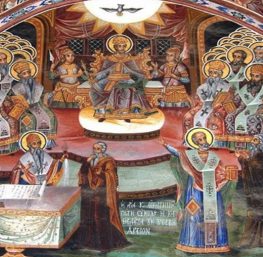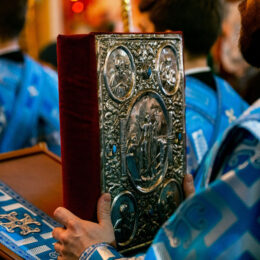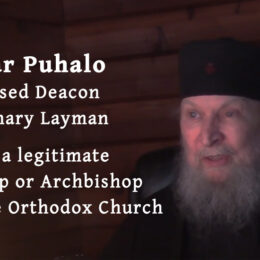OrthodoxyToday.org | Bishop Hilarion Alfeyev | Feb. 21, 2009
According to a widespread view, the Orthodox Church is not a missionary church. Some Orthodox even claim that the Orthodox Church does not need any mission. “We are the holders of the Truth, and we testify to it by the very fact of our existence,” said proudly one Orthodox clergyman with whom I was speaking on this subject. One wonders, though, whether this approach can be justified by the church history. If the apostles after Christ’s Resurrection sat behind closed doors in Jerusalem, testifying to the truth by the simple fact of their existence, any further spread of Christianity would have been extremely unlikely.
Any Christian church has to be missionary if it wants to be faithful to its call to be the Church. The Orthodox history knows many great missionaries, among whom there are men and women, bishops, monks and lay people. St Nina the Enlightener of Georgia (4th c.), St Vladimir the Baptiser of Russia and his grandmother Olga (10th c.), St Cyril and Methodius (10th c.), St Nicholas of Japan (19th c.) and many others are venerated as “equal to the apostles”.
Orthodoxy in Noth America, Japan and China is a fruit of missionary activity of the Russian Orthodox Church. Orthodoxy came to North America from Russia through Alaska (which, as Governor Sarah Palin has recently reminded us, is “sort of near the eastern border of Russia”). Among the first Russian missionaries was St Herman of Alaska, a simple monk from Valamo monastery, who came to Alaska in 1794 and spent more than 40 years there, until his death in 1837. He was venerated as a saint by local people already during his lifetime and was regarded as their intercessor before God.
The first episcopal see in America was established by the Holy Synod of the Russian Orthodox Church in 1840, but the ruling bishop of this diocese, St Innocent (Veniaminov), future Metropolitan of Moscow, lived in Novoarchangelsk. In 1872, five years after the sale of Alaska to America, the see of the Russian bishop was transferred to San Francisco. From 1898 to 1907 St Tikhon, future Patriarch of Russia, governed the diocese. During his time the see was transferred to New York. It was he who organized the all-American council of 1907, which renamed the diocese as the “Russian Orthodox Greek Catholic Church in North America”. Thus began the future autocephalous American Orthodox Church.
During St Tikhon’s tenure in America a large number of Antiochian Christians arrived in the New World, for whom a Syrian-born assistant bishop, Raphael of Brooklyn, was ordained in 1903 at the request of St Tikhon. Thus began a new, unique ecclesiological model which foresaw that bishops of different nationalities could act within one Local Church and on the same canonical territory, with dioceses being created not on the basis of territory, but ethnicity. Such a model did not correspond to the ecclesiology of the Ancient Church, but it did correspond to the new reality which emerged as a result of immigration to Europe and America. If events had continued according to the plan outlined by St Tikhon, a Local Orthodox Church in America could have been created in the 1920s, headed by one metropolitan, under whom bishops of various nationalities would be in submission, with each caring for the flock of his own ethnic background, be it Russians, Ukrainians, Greeks, Antiochians, Romanians etc.
However, as a result of the mass immigration of Greeks from the former Ottoman Empire to Europe, America and Australia in the 1920s, metropolies of the Patriarchate of Constantinople were created on these continents. The Patriarchate of Constaninople declared its jurisdiction over the entire church “diaspora”, i.e. over all countries not within the borders of historical Orthodox Churches. According to this viewpoint, practically all of Western Europe, North and South America as well as Australia and Oceania, were encompassed by this definition of “diaspora”. In America, however, there already existed an Orthodox Church headed by a Russian metropolitan. Thus the creation there of a jurisdiction of Constantinople introduced divisions into American Orthodoxy, which was exacerbated after the establishment of jurisdictions of the Antiochian, Romanian and Serbian Patriarchates.
In 1970 the Russian Orthodox Church, inspired as before by the vision of St Tikhon, who dreamed of a single Orthodox Church on the American continent, granted autocephaly to that part of American Orthodoxy which was previously under its canonical authority. It was hoped that the Orthodox of other jurisdictions would eventually join this autocephalous Church, which received the name “Orthodox Church in America”. However, this has not yet happened, and in the Americas there are currently metropolies, archdioceses and dioceses of several Local Orthodox Churches alongside the autocephalous Orthodox Church in America.
In spite of a certain “jurisdictional mess”, which is, regrettably, characteristic of the Orthodox Church not only on the American continent, but also in other parts of the world, including Western Europe, the Orthodox Church worldwide contiues to be involved in a variety of missionary activities. One of the most notable theologians of the twentieth century, Father Alexander Schmemann, wrote several decades ago:
To recover the missionary dimension of the Church is today’s greatest imperative. We have to recover a very basic truth: that the Church is essentially Mission, that the very roots of her life are in the commandment of Christ: “Go ye therefore and teach all nations” (Matt. 28:19). A Christian community that would lose this missionary zeal and purpose, that would become selfish and self-centered, that would limit itself to “satisfying the spiritual needs of its members”, that would identify itself completely with a nation, a society, a social or ethnic group – is on its way to spiritual decadence and death, because the essential spiritual need of a Christian is precisely that of sharing the life and the Truth with as many men as possible and ultimately with the whole world. Mission thus is the organic need and task of the Church in the world, the real meaning of Church’s presence in history between the first and the second advents of her Lord, or, in other terms, the meaning of Christian history. Obviously not all members of the Church can go and preach in the literal sense of the word. But all can have a concern for the missionary function of the Church, feel responsible for it, help and support it. In this respect each diocese, each parish and each member of the Church are involved in the missionary ministry.
In what follows I shall concentrate not so much on missionary activities as such, on various missionary tools, tactics and strategies which were, are and will be employed by the Orthodox Church. I shall rather attempt to outline certain features of Orthodox theology, liturgy and spirituality, which, I believe, have a strong missionary potential ingrained in them and which will give strength to the Orthodox Church in its mission in the 21st century.
The Orthodox Church as “The Church of the Fathers”
On the first Sunday of Lent, which is called the Sunday of Orthodoxy, during a special service a protodeacon exclaims: “This faith is Orthodox, this faith is apostolic, this faith is patristic, this faith enlightened the universe”. It is more or less obvious why Christian faith should be “apostolic” and “Orthodox”. But why should it be “patristic”? Does this imply that Orthodoxy must be necessarily styled as in the “patriarchal days of old”? Or is it that, as Christians, we should always be turned towards the past instead of living in the present or working for the future? Should perhaps some “golden age” in which the great Fathers of the Church lived, the 4th century for instance, be our ideal, a bearing to guide us? Or, finally, could this imply that the formation of our theological and ecclesial tradition saw its completion during the “patristic era,” and that, subsequently, nothing new could unfold in Orthodox theology and church life in general?
If this were so – and there are many who think exactly in this way – it would mean that our principal task is to watch over what remains of the Byzantine and Russian legacy, and vigilantly guard Orthodoxy against the infectious trends of modern times. Some act in precisely this way: fearfully rejecting the challenges of modernity, they dedicate all their time to preserving what they perceive as the traditional teaching of the Orthodox Church, explaining that in the present time of “universal apostasy” there is no place for any creative understanding of Tradition, since everything had been clarified by the Fathers centuries earlier. Such supporters of “protective Orthodoxy” prefer, as a rule, to refer to the “teachings of the holy Fathers.” Yet in reality many of them do not know patristic doctrine: they make use of isolated notions to justify their own theories and ideas without studying patristic theology in all its pluriformity and fullness.
Were we to concentrate our energies solely on preserving the accumulated wisdom of past Fathers, then things would be quite simple. If, however, our vocation is to invest the talent of the patristic legacy, we would find ourselves confronted by a tremendous task indeed, not only one that would include study of works of the Fathers, but also their interpretation in the light of contemporary experience. Similarly, it would require an interpretation of our own contemporary experience in the light of patristic teaching. This evaluation does not only mean studying the Fathers; the task before us is also to think and to live in a patristic way. We shall never be able to understand the Fathers if we do not share, at least to some degree, in their experience and endeavours.
This is a tremendous and inspiring task; it is also quite hazardous. Just as no financial investor is immune from bankruptcy, neither is a theologian who approaches the patristic legacy in a creative way preserved from error. The distance – in time, culture, and spirituality – between the Fathers and us is too great; it would seem to be impossible to surmount the obstacles that confound our attempts to penetrate the mind of the Fathers. Yet so long as we fail to overcome them, we shall never be able to fulfil the mission entrusted to us by the modern age. This mission consists in possessing the capacity not only to make our faith truly “patristic,” but also to express it in a language accessible to 21st century men and women.
[…]
Orthodoxy in dialogue
One could say much more about the missionary potential of the Orthodox Church, in particular, about the Orthodox icon as a missionary tool, as well as about the church music. In the remainder of my lecture, however, I would like to concentrate on something entirely different. I would like to say a few words about who are and will be the main opponents of the Orthodox mission in the 21st century, and who are likely to become the Orthodox Church’s closest partners in its missionary activity.
I believe that the m21st century will continue to be marked by the two ongoing conflicts, or battles, which will inevitably affect the mission and witness of the Orthodox Church. The first battle is that between Christianity and “militant secularism”. In modern secular society Christian values are being more and more marginalized and God is being driven to the outskirts of human existence. In many countries of the West it is now almost taken for granted that religion can operate only at the private level: you are free to believe in God or not, but this should in no way be manifested in your social life. Churches and religious communities are tolerated so long as they do not trespass their own borders, so long as they refrain from publicly expressing opinions that differ from those consonant with “political correctness”. Should they begin to express such opinions, they are readily accused of intolerance. The secular press is largely negative towards Christianity. Youth culture is predominantly anti-religious and largely anti-Christian. Moral standards accepted by modern society are markedly different from those that were until recently accepted by most Christian communities.
The second ongoing battle, which is likely to continue in the 21st century, is that between the two markedly different versions of Christianity. There is now a deep-seated discrepancy between Christian communities, such as the Orthodox, that attempt to preserve the sacred Tradition of the ancient, undivided Church, and those, like many Reform communities, that have revised and continue to revise Tradition in conformity with secular standards. This divergence is as evident at the level of religious teaching, including doctrine and ecclesiology, as it is at the level of church practice, such as worship and morality.
In my opinion, the recent liberalization of teaching and practice in many Protestant churches has greatly alienated them from both the Orthodox and the Catholics. It has also undermined the common Christian witness to the secularized world. The voice of Christendom is nowadays deeply disunited: we preach contradictory moral standards; our doctrinal positions are divergent; and our social perspectives vary a great deal. One wonders whether we can still speak at all of “Christianity” or whether it would be more accurate to refer to “Christianities,” that is to say, markedly diverse versions of the Christian faith.
Many Christian communities, particularly in Western Europe and North America, are experiencing a catastrophic shortage of vocations. But what is the reason for this? One, surely, is the mounting militant secularism that steals millions of the faithful, especially the youth. Another, however, is the doctrinal and moral liberalism within some Christian communities. It not only undermines their credibility in the eyes of the secular world but also makes Christianity uninteresting and irrelevant, for it neither challenges secular society nor has anything significantly different to offer to young people educated in a worldly culture.
. . . more



